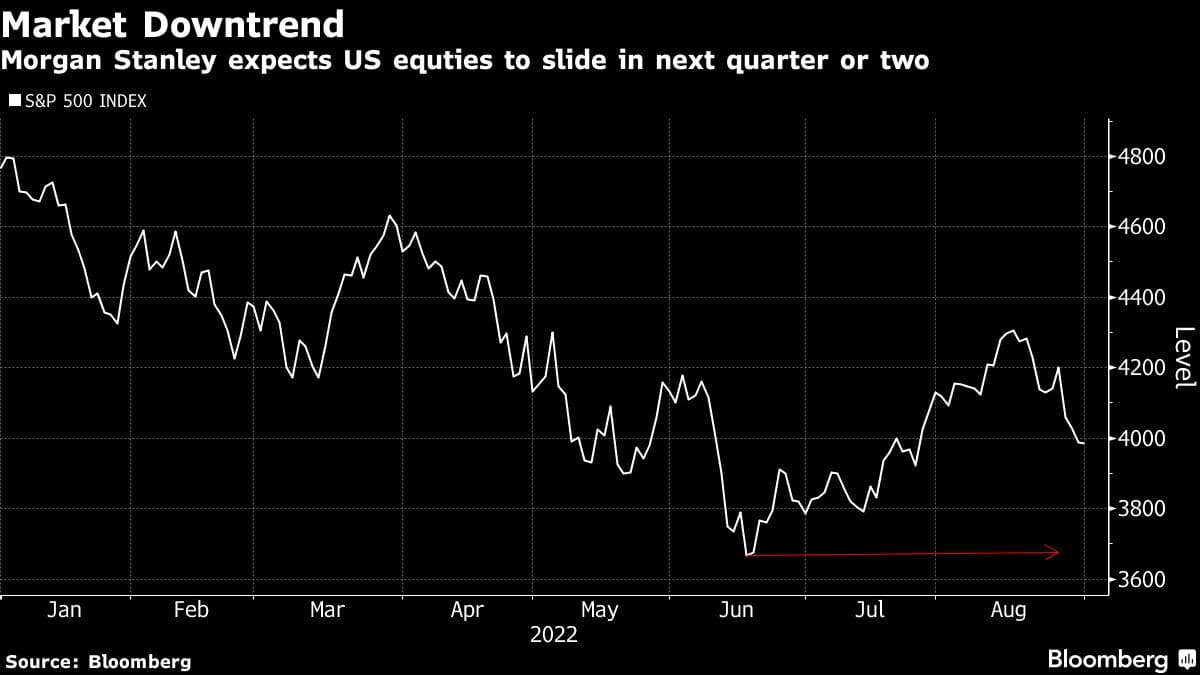
Representative image
Investors should brace for more pain as US stock indexes haven’t yet hit bottom for the year, according to Mike Wilson, chief US equity strategist at Morgan Stanley.
“The index usually is the last thing to fall,” Wilson, who’s predicted this year’s equity selloff, told “Bloomberg Markets” Wednesday, referring to the S&P 500. “June probably was the low for the average stock, but the index, we think, still has to take out of those June lows.”
The US benchmark gauge surged as much as 17% from its mid-June low of 3,666.77, following a plunge of more than 20% during the first half. The S&P 500 has then tumbled since mid-August amid concern that the Federal Reserve’s aggressive monetary tightening could tip the economy into a recession.

“We view 3,400 for the growth recession or soft landing” scenario, Wilson noted.
That would imply a 15% slide for the S&P 500 from Tuesday’s close. A “proper recession” would bring the index somewhere close to 3,000. And while it is difficult to predict a market bottom, the bank’s chief US equity strategist said the “direction is down at least for the next quarter or two.”
US stocks struggled to find solid footing in the final day of August, a month that has seen everything from Treasuries to commodities retreat as central banks ramped up their efforts to thwart scorching inflation. Investors anxiously awaited Friday’s jobs report, which should provide more clues on the pace of Fed hikes.
Trends in operating margins were worse than forecast, Wilson noted, while adding that he expects this negative direction to continue.
“P/E multiple is wrong not because the Fed is going to be hawkish, but because the equity market is being too optimistic about the earnings outlook,” Wilson, said referring to the price-to-earnings ratio. “The multiples will start to come down as earnings get cut and then somewhere in the middle of that earnings cut process the market will bottom and we think that’s probably between September and December.”
At the low in June, the S&P 500 was trading at 18 times earnings, a multiple that exceeded trough valuations seen in all previous 11 bear cycles since the 1950s. The current P/E for the index sits above 19.
Meantime, S&P 500 profit estimates for 2023 have been falling in recent weeks. Consensus earnings are off $ 6.60 a share for the next four quarters in aggregate, with the expectations for the third quarter taking the biggest hit, Bloomberg Intelligence strategists Gina Martin Adams and Wendy Soong said in a note published Aug. 18.
As the Fed remains laser-focused on economic data, Wilson thinks the central bank is “always going to be late by design” since it relies on two of the most backward looking data points: labor market data and inflation.
“By the time the labor market falls apart, it’s too late,” he said, since by then it will be evident that the US economy is in a recession. “The Fed is relevant but I think we priced most of the Fed pain after the first of the year,” he added.
Several Fed officials, the latest being Cleveland Fed President Loretta Mester, have independently stressed their commitment to combating a four-decade inflation high this week, but remained vague on how big their policy move will be next month.
Fed Chair Jerome Powell in a speech Aug. 26 at the Fed’s annual retreat in Jackson Hole, Wyoming, said that bringing price pressures down toward their 2% target was the Fed’s “overarching focus.”
Still, despite the market volatility, energy shares continue to outperform the broader index. This is why Wilson, whose firm is neutral on the sector, suggested looking at the S&P 500 excluding that industry.
“When energy is doing well it’s usually bad for everything else,” he said, adding the divergence will continue. “Energy is really the antithesis for everything else.”
